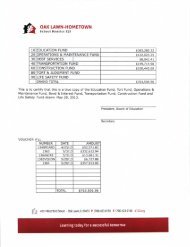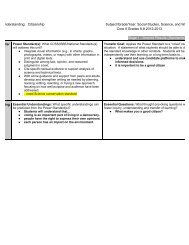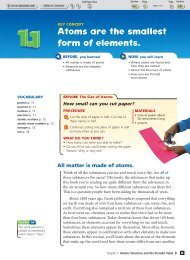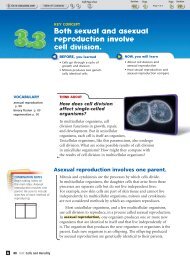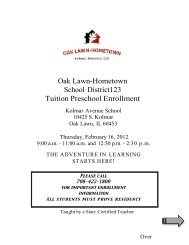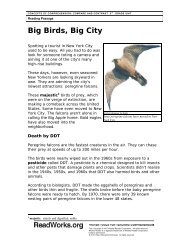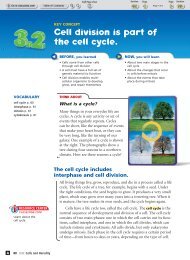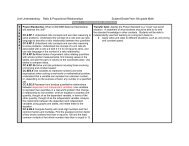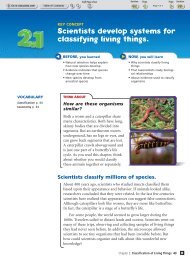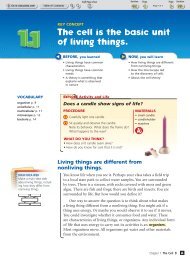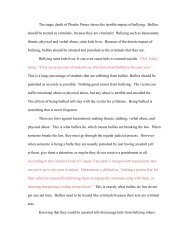Force and mass determine acceleration.
Force and mass determine acceleration.
Force and mass determine acceleration.
Create successful ePaper yourself
Turn your PDF publications into a flip-book with our unique Google optimized e-Paper software.
KEY CONCEPT<br />
<strong>Force</strong> <strong>and</strong> <strong>mass</strong><br />
<strong>determine</strong> <strong>acceleration</strong>.<br />
BEFORE, you learned<br />
• Mass is a measure of inertia<br />
• The motion of an object<br />
will not change unless the<br />
object is acted upon by an<br />
unbalanced force<br />
NOW, you will learn<br />
• How Newton’s second law<br />
relates force, <strong>mass</strong>, <strong>and</strong><br />
<strong>acceleration</strong><br />
• How force works in<br />
circular motion<br />
VOCABULARY<br />
Newton’s second law p. 50<br />
centripetal force p. 54<br />
EXPLORE Acceleration<br />
How are force <strong>and</strong> <strong>acceleration</strong> related?<br />
PROCEDURE<br />
1<br />
2<br />
3<br />
Tie a paper clip to each end of a long string.<br />
Hook two more paper clips to one end.<br />
Hold the single paper clip in the middle of a<br />
smooth table; hang the other end of the<br />
string over the edge. Let go <strong>and</strong> observe.<br />
Add one more paper clip to the hanging end <strong>and</strong> repeat<br />
the experiment. Observe what happens. Repeat.<br />
MATERIALS<br />
• paper<br />
clips<br />
• string<br />
WHAT DO YOU THINK?<br />
• What happened each time that you let go of the single paper clip?<br />
• Explain the relationship between the number of hanging paper<br />
clips <strong>and</strong> the motion of the paper clip on the table.<br />
reminder<br />
Acceleration is a change<br />
in velocity over time.<br />
Newton’s second law relates force,<br />
<strong>mass</strong>, <strong>and</strong> <strong>acceleration</strong>.<br />
Suppose you are eating lunch with a friend <strong>and</strong> she asks you to pass<br />
the milk container. You decide to slide it across the table to her. How<br />
much force would you use to get the container moving? You would<br />
probably use a different force if the container were full than if the<br />
container were empty.<br />
If you want to give two objects with different <strong>mass</strong>es the same<br />
<strong>acceleration</strong>, you have to apply different forces to them. You must<br />
push a full milk container harder than an empty one to slide it over<br />
to your friend in the same amount of time.<br />
check your reading<br />
What three concepts are involved in Newton’s second law?<br />
Chapter 2: <strong>Force</strong>s 49<br />
CD
SIMULATION<br />
CLASSZONE.COM<br />
Explore Newton’s<br />
second law.<br />
Newton’s Second Law<br />
Newton studied how objects move, <strong>and</strong> he noticed some patterns. He<br />
observed that the <strong>acceleration</strong> of an object depends on the <strong>mass</strong> of the<br />
object <strong>and</strong> the size of the force applied to it. Newton’s second law<br />
states that the <strong>acceleration</strong> of an object increases with increased force<br />
<strong>and</strong> decreases with increased <strong>mass</strong>. The law also states that the direction<br />
in which an object accelerates is the same as the direction of the force.<br />
The photographs below show Newton’s second law at work in a<br />
supermarket. The <strong>acceleration</strong> of each shopping cart depends upon<br />
two things:<br />
• the size of the force applied to the shopping cart<br />
• the <strong>mass</strong> of the shopping cart<br />
In the left-h<strong>and</strong> photograph, the force on the cart changes, while<br />
the <strong>mass</strong> of the cart stays the same. In the right-h<strong>and</strong> photograph, the<br />
force on the cart stays the same, while the <strong>mass</strong> of the cart varies.<br />
Notice how <strong>mass</strong> <strong>and</strong> force affect <strong>acceleration</strong>.<br />
Newton’s Second Law<br />
The <strong>acceleration</strong> of an object increases with increased force,<br />
decreases with increased <strong>mass</strong>, <strong>and</strong> is in the same direction<br />
as the force.<br />
Increasing <strong>Force</strong> Increases Acceleration<br />
Increasing Mass Decreases Acceleration<br />
small force<br />
larger force small <strong>mass</strong> larger <strong>mass</strong><br />
<strong>acceleration</strong><br />
<strong>acceleration</strong><br />
The force exerted on the cart by the man is<br />
greater than the force exerted on the same cart<br />
by the boy, so the <strong>acceleration</strong> is greater.<br />
<strong>acceleration</strong><br />
<strong>acceleration</strong><br />
The <strong>mass</strong> of the full cart is greater than the <strong>mass</strong><br />
of the empty cart, <strong>and</strong> the boy is pushing with the<br />
same force, so the <strong>acceleration</strong> is less.<br />
What do the arrows in these diagrams show?<br />
CD 50 Unit: Motion <strong>and</strong> <strong>Force</strong>s
<strong>Force</strong> Equals Mass Times Acceleration<br />
Newton was able to describe the relationship of force, <strong>mass</strong>, <strong>and</strong> <strong>acceleration</strong><br />
mathematically. You can calculate the force, the <strong>mass</strong>, or the<br />
<strong>acceleration</strong> if you know two of the three factors. The mathematical<br />
form of Newton’s second law, stated as a formula, is<br />
<strong>Force</strong> = <strong>mass</strong> · <strong>acceleration</strong><br />
F = ma<br />
To use this formula, you need to underst<strong>and</strong> the unit used to<br />
measure force. In honor of Newton’s contribution to our underst<strong>and</strong>ing<br />
of force <strong>and</strong> motion, the st<strong>and</strong>ard unit of force is called the<br />
newton (N). Because force equals <strong>mass</strong> times <strong>acceleration</strong>, force is<br />
measured in units of <strong>mass</strong> (kilograms) times units of <strong>acceleration</strong><br />
(meters per second per second). A newton is defined as the amount of<br />
force that it takes to accelerate one kilogram (1 kg) of <strong>mass</strong> one meter<br />
per second per second (1 m/s 2 ). So 1 N is the same as 1 kg p m/s 2 .<br />
reminder<br />
Meters per second per<br />
second is the same as m/s 2 ,<br />
which can be read “meters<br />
per second squared.”<br />
check your reading<br />
If the same force is applied to two objects of different <strong>mass</strong>,<br />
which object will have the greater <strong>acceleration</strong>?<br />
The mathematical relationship of force, <strong>mass</strong>, <strong>and</strong> <strong>acceleration</strong> allow<br />
you to solve problems about how objects move. If you know the <strong>mass</strong><br />
of an object <strong>and</strong> the <strong>acceleration</strong> you want to achieve, you can use the<br />
equation to find the force you need to exert to produce that <strong>acceleration</strong>.<br />
Use Newton’s second law to find the force that is needed to<br />
accelerate the shopping cart in the sample problem.<br />
Calculating <strong>Force</strong><br />
Sample Problem<br />
What force is needed to accelerate a 10 kg shopping cart 3 m/s 2 ?<br />
Practice the Math<br />
What do you know? <strong>mass</strong> = 10 kg, <strong>acceleration</strong> = 3 m/s 2<br />
What do you want to find out?<br />
<strong>Force</strong><br />
Write the formula: F = ma<br />
Substitute into the formula: F = 10 kg p 3 m/s 2<br />
Calculate <strong>and</strong> simplify:<br />
F = 10 kg p 3 m<br />
s<br />
2 = 30 kg p m/s<br />
2<br />
Check that your units agree: Unit is kg p m/s 2 .<br />
Unit of force is newton, which is<br />
also kg p m/s 2 . Units agree.<br />
Answer:<br />
F = 30 N<br />
1. If a 5 kg ball is accelerating 1.2 m/s 2 , what is the force on it?<br />
2. A person on a scooter is accelerating 2 m/s 2 . If the person has a <strong>mass</strong> of<br />
50 kg, how much force is acting on that person?<br />
Chapter 2: <strong>Force</strong>s 51<br />
CD
This team of 20 people<br />
pulled a 72,000-kilogram<br />
(159,000 lb) Boeing 727<br />
airplane 3.7 meters (12 ft)<br />
in 6.74 seconds.<br />
The photograph above shows people who are combining forces to<br />
pull an airplane. Suppose you knew the <strong>mass</strong> of the plane <strong>and</strong> how<br />
hard the people were pulling. How much would the plane accelerate?<br />
The sample problem below shows how Newton’s second law helps you<br />
calculate the <strong>acceleration</strong>.<br />
Calculating Acceleration<br />
Sample Problem<br />
If a team pulls with a combined force of 9000 N on an airplane with<br />
a <strong>mass</strong> of 30,000 kg, what is the <strong>acceleration</strong> of the airplane?<br />
What do you know?<br />
What do you want to find out?<br />
Rearrange the formula:<br />
<strong>mass</strong> = 30,000 kg, force = 9000 N<br />
<strong>acceleration</strong><br />
a = m<br />
F <br />
Substitute into the formula: a = <br />
9000<br />
30 , 00<br />
N<br />
0 kg<br />
9000<br />
Calculate <strong>and</strong> simplify: a = 30 , 00<br />
N<br />
0 kg<br />
= 9000 kg p m/s<br />
<br />
2<br />
= 0.3 m/s 2<br />
30,000 kg<br />
Check that your units agree: Unit is m/s 2 .<br />
Unit for <strong>acceleration</strong> is m/s 2 .<br />
Units agree.<br />
Answer: a = 0.3 m/s 2<br />
Practice the Math<br />
1. Half the people on the team decide not to pull the airplane. The combined<br />
force of those left is 4500 N, while the airplane’s <strong>mass</strong> is still 30,000 kg.<br />
What will be the <strong>acceleration</strong>?<br />
2. A girl pulls a wheeled backpack with a force of 3 N. If the backpack has a<br />
<strong>mass</strong> of 6 kg, what is its <strong>acceleration</strong>?<br />
CD 52 Unit: Motion <strong>and</strong> <strong>Force</strong>s
Mass <strong>and</strong> Acceleration<br />
Mass is also a variable in Newton’s second law. If the same force<br />
acts on two objects, the object with less <strong>mass</strong> will have the greater<br />
<strong>acceleration</strong>. For instance, if you push a soccer ball <strong>and</strong> a bowling<br />
ball with equal force, the soccer ball will have a greater <strong>acceleration</strong>.<br />
If objects lose <strong>mass</strong>, they can gain <strong>acceleration</strong> if the force remains<br />
the same. When a rocket is first launched, most of its <strong>mass</strong> is the fuel<br />
it carries. As the rocket burns fuel, it loses <strong>mass</strong>. As the <strong>mass</strong> continually<br />
decreases, the <strong>acceleration</strong> continually increases.<br />
APPLY This NASA launch<br />
rocket accelerates with<br />
enough force to lift about<br />
45 cars off the ground.<br />
As the rocket loses fuel,<br />
will it accelerate more or<br />
less? Why?<br />
Calculating Mass<br />
Sample Problem<br />
A model rocket is accelerating at 2 m/s 2 . The force on it is 1 N.<br />
What is the <strong>mass</strong> of the rocket?<br />
What do you know?<br />
What do you want to find out?<br />
Rearrange the formula:<br />
<strong>acceleration</strong> = 2 m/s 2 , force = 1 N<br />
<strong>mass</strong><br />
m = a<br />
F <br />
1 N<br />
Substitute into the formula: m = <br />
2 m/s 2<br />
1 N<br />
Calculate <strong>and</strong> simplify: m = 2 m/s 2<br />
= 1k 2<br />
g p m/s 2<br />
<br />
m/<br />
s 2 =0.5 kg<br />
Check that your units agree:<br />
Practice the Math<br />
Answer:<br />
Unit is kg.<br />
Unit of <strong>mass</strong> is kg. Units agree.<br />
m = 0.5 kg<br />
1. Another model rocket is accelerating at a rate of 3 m/s 2 with a force of 1 N.<br />
What is the <strong>mass</strong> of the rocket?<br />
2. A boy pushes a shopping cart with a force of 10 N, <strong>and</strong> the cart accelerates<br />
1 m/s 2 . What is the <strong>mass</strong> of the cart?<br />
<strong>Force</strong>s can change the direction of motion.<br />
Usually, we think of a force as either speeding up or slowing down the<br />
motion of an object, but force can also make an object change direction.<br />
If an object changes direction, it is accelerating. Newton’s second<br />
law says that if you apply a force to an object, the direction in which<br />
the object accelerates is the same as the direction of the force. You can<br />
change the direction of an object without changing its speed. For<br />
example, a good soccer player can control the motion of a soccer ball<br />
by applying a force that changes the ball’s direction but not its speed.<br />
check your reading<br />
How can an object accelerate when it does not change speed?<br />
Chapter 2: <strong>Force</strong>s 53<br />
CD
Motion <strong>and</strong> <strong>Force</strong><br />
What affects circular motion?<br />
PROCEDURE<br />
1<br />
2<br />
3<br />
Spread newspaper over your work<br />
surface. Place the paper plate<br />
down on the newspaper.<br />
Practice rolling the marble around<br />
the edge of the plate until you<br />
can roll it around completely at<br />
least once.<br />
Cut out a one-quarter slice of the<br />
paper plate. Put a dab of paint on<br />
the edge of the plate where the<br />
WHAT DO YOU THINK?<br />
4<br />
5<br />
marble will leave it. Place the plate<br />
back down on the newspaper.<br />
Hypothesize: How will the marble<br />
move once it rolls off the plate?<br />
Why?<br />
Roll the marble all the way around<br />
the paper plate into the cut-away<br />
section <strong>and</strong> observe the resulting<br />
motion as shown by the trail<br />
of paint.<br />
• Did your observations support your hypothesis?<br />
•What forces affected the marble’s motion after it left the plate?<br />
CHALLENGE How will changing the speed at which you roll the<br />
marble change your results? Repeat the activity to test your prediction.<br />
SKILL FOCUS<br />
Hypothesizing<br />
MATERIALS<br />
• newspaper<br />
• paper plate<br />
• marble<br />
• scissors<br />
• poster paint<br />
• paintbrush<br />
TIME<br />
15 minutes<br />
VOCABULARY<br />
Remember to make a<br />
magnet word diagram<br />
for centripetal force.<br />
Centripetal <strong>Force</strong><br />
When you were younger, you may have experimented with using force<br />
to change motion. Perhaps you <strong>and</strong> a friend took turns swinging each<br />
other in a circle. If you remember this game, you may also remember<br />
that your arms got tired because they were constantly pulling your<br />
friend as your friend spun around. It took force to change the direction<br />
of your friend’s motion. Without that force, your friend could not<br />
have kept moving in a circle.<br />
Any force that keeps an object moving in a circle is known as a<br />
centripetal force (sehn-TRIHP-ih-tuhl). This force points toward the<br />
center of the circle. Without the centripetal force, the object would go<br />
flying off in a straight line. When you whirl a ball on a string, what<br />
keeps the ball moving in a circle? The force of the string turns the ball,<br />
changing the ball’s direction of motion. When the string turns, so<br />
does the ball. As the string changes direction, the force from the string<br />
also changes direction. The force is always pointing along the string<br />
toward your h<strong>and</strong>, the center of the circle. The centripetal force on the<br />
whirling ball is the pull from the string. If you let go of the string, the<br />
ball would fly off in the direction it was headed when you let go.<br />
check your reading<br />
How does centripetal force change the motion of an object?<br />
CD 54 Unit: Motion <strong>and</strong> <strong>Force</strong>s
centripetal force<br />
top view<br />
Centripetal force<br />
The force that keeps the<br />
female skater moving in a<br />
circle is the pull exerted by<br />
her partner. The diagram<br />
shows the direction of the<br />
centripetal force.<br />
Circular Motion <strong>and</strong> Newton’s Second Law<br />
Suppose the male skater shown above spins his partner faster. Her<br />
direction changes more quickly than before, so she accelerates more.<br />
To get more <strong>acceleration</strong>, he must apply more force. The same idea<br />
holds for a ball you whirl on a string. You have to pull harder on the<br />
string when you whirl the ball faster, because it takes more centripetal<br />
force to keep the ball moving at the greater speed.<br />
You can apply the formula for Newton’s second law even to an<br />
object moving in a circle. If you know the size of the centripetal<br />
force acting upon the object, you can find its <strong>acceleration</strong>. A greater<br />
<strong>acceleration</strong> requires a greater centripetal force. A more <strong>mass</strong>ive object<br />
requires a greater centripetal force to have the same circular speed as a<br />
less <strong>mass</strong>ive object. But no matter what the <strong>mass</strong> of an object is, if it<br />
moves in a circle, its force <strong>and</strong> <strong>acceleration</strong> are directed toward the<br />
center of the circle.<br />
check your reading<br />
How does increasing the centripetal force on an object<br />
affect its <strong>acceleration</strong>?<br />
KEY CONCEPTS<br />
1. If the force acting upon an<br />
object is increased, what<br />
happens to the object’s<br />
<strong>acceleration</strong>?<br />
2. How does the <strong>mass</strong> of an<br />
object affect its <strong>acceleration</strong>?<br />
3. What force keeps an object<br />
moving in a circle? In what<br />
direction does this force act?<br />
CRITICAL THINKING<br />
4. Infer Use Newton’s second<br />
law to <strong>determine</strong> how much<br />
force is being applied to an<br />
object that is traveling at a<br />
constant velocity.<br />
5. Calculate What force is<br />
needed to accelerate an object<br />
5 m/s 2 if the object has a <strong>mass</strong><br />
of 10 kg?<br />
CHALLENGE<br />
6. Synthesize Carlos pushes a<br />
3 kg box with a force of 9 N.<br />
The force of friction on the box<br />
is 3 N in the opposite direction.<br />
What is the <strong>acceleration</strong> of the<br />
box? Hint: Combine forces to<br />
find the net force.<br />
Chapter 2: <strong>Force</strong>s 55<br />
CD



